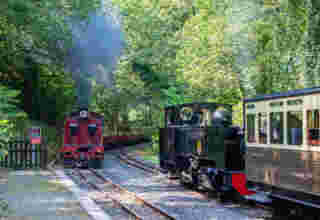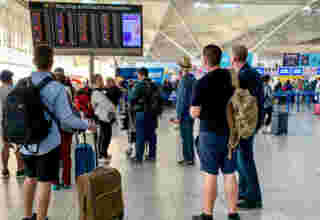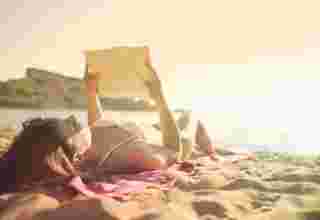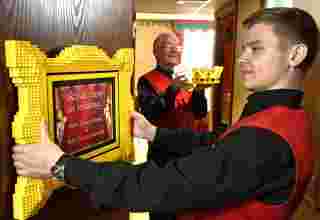What is it? A cultural expedition during Autumn half-term.
Where? Berlin. We spent four nights at the Hilton Berlin, a luxury hotel overlooking one of the city’s prettiest squares.
Description: [first.jpg]Berlin is justifiably renowned as a cultural Mecca within Europe, with a wide array of family-friendly activities. But is it really one of the most “happening” cities in Europe as well? Delia Lloyd, her husband and two children went to find out…
To test out Berlin’s reputation as one of Europe’s most culturally “happening” cities.
Start the day with breakfast atop the TV Tower Fernsehturm, with gorgeous views of the historic centre of Berlin (www.tv-turm.de). While you eat, the cafe turns 360 degrees (book in advance to avoid queues!). From there, make your way to the spectacular Brandenburg Gate 9, and then continue on the Reichstag (German parliament), where you can climb the gorgeous glass dome designed by Sir Norman Foster. If it’s nice out, rent some bikes (www.berlinonbike.de) and pedal along the river through the government quarter to see the newly renovated buildings. You can also tour the city by boat or on a sight-seeing bus, which lets you get on and off at assorted destinations (inquire at your hotel about the many different options). Or take to the skies in the ‘die welt’ hot air balloon, which departs near Checkpoint Charlie. When everyone’s knackered, enjoy a leisurely tour of the city’s bakeries (for comparison purposes only, of course!). If you have time, a day trip to Potsdam is highly recommended.
Berlin is home to all major cuisines, and is particularly famous for its Turkish food. Be sure to go down to the artsy Kreuzberg neighborhood and try a kebab. One shouldn’t leave the city without having a currywurst, and I can highly recommend Konnopkes Imbiss, a famous stand under the U2 line. The cabaret at Bar Jeder Vernunft in the trendy Prenzlauer Berg district is fun for cocktails or a pre-show dinner, and Rosi’s Bar provides cabaret and live music in a friendly, warehouse setting (http://www.rosis-berlin.de/). The Rodeo restaurant in a former postal depot near the Neue Synagogue contains several fancy bars and restaurants inside. You can also book a Night Club tour though most major hotels. If you enjoy classical music, a concert at the Philharmonie (Berlin philharmonic concert hall) is apparently not to be missed, and opera buffs will want to check out one of Berlin’s three major opera houses. Or you can dine in at the elegant Mark Brandenburg restaurant inside the Hilton, which features regional cuisine.
Although we didn’t take advantage of this opportunity, Hilton Berlin was happy to book a sitter for us and other hotels can make similar arrangements.
Hotel Berlin has a fitness center, whirlpool, solarium and beauty salon located on the premises.
Local activities: See above.
Wish we had known: In order to take advantage of the Museum pass (which, for 19 Euros, gives you access to 70 museums over a three-day period) you need to go to Museum Island first. We visited several smaller museums around the city before making our way to Museum Island and we could have saved a lot of money if we’d done that first. The same holds for the Welcome Card, which offers unlimited transportation around the city (as well as discounts on many museums) for three days, but can only be purchased at major train stations, airports or tourist offices.
Our top tip: Be sure to carry lots of cash on you at all times. We were shocked at how many restaurants – even in museums and airports – did not take credit cards.
Kids say: Isaac, 9: “We should live at Museum Island!” Allie, 6: “Can we have breakfast at the hotel again?”
Getting There: All major European airlines fly from London to Berlin, as do Easy Jet and Ryan Air, starting as low as L30 return (Ryan Air.) Book early to get good seats and fares. Hotels in Berlin come at all levels and prices. Hilton Berlin does not have a family suite, but you can add a bed to any regular room for an additional 50 Euros, or to a junior suite for an additional 120 Euros. Check the website for special offers.
About our stay: Two events in German history – the Holocaust and the construction of the Berlin Wall – define Berlin, both culturally and architecturally. On a family visit to this city you will want to explore these two historic themes, while at the same time enjoying a wide variety of family-oriented activities. We stayed at the Hilton Berlin, which is located on the historic Gendarmenmarkt, often thought to be Berlin’s prettiest square. This is a terrific hotel if you have children. Young ones can “check in” separately through the My Little Hilton program (be sure to book online in advance), which provides them with a backpack filled with arts activities. There’s also a swimming pool and an ample breakfast buffet – American style – which left my kids breathless. The Hilton is housed in a beautifully restored building in what was formerly East Berlin. The staff were fluent in English, extremely knowledgeable and helped us with a range of tasks, from obtaining a complimentary copy of the International Herald Tribune at breakfast each morning, to booking my mother on one of the sightseeing bus tours, to giving us precise directions around the city when my husband had a business engagement. The rooms were comfortable and elegant with a full array of modern appointments, and we were particularly happy that our kids could comfortably sleep in two separate, full-sized cots, rather than being squished into a sofa bed. In addition to its family-friendly hospitality, the Hilton Berlin is also perfectly located to explore the city’s many charms. I would begin with a visit to Museum Island, which is a 15-20 minute walk from the hotel. Be sure you pass through the historic Bebel Platz where you will discover one of the most moving (and easy to miss) monuments to the Holocaust I’ve ever seen. The more famous Holocaust Memorial is also worth seeing. [fourth.jpg] After you’ve purchased your Museum pass, choose from among the five museums of antiquities that sit on the island. We were particularly taken with the Pergamon-museum, which takes its name from the famous Pergamon Altar which has been re-built (actual size!) in the main hall. But it is the reconstructed Ishtar Gate – with its original, glazed, cobalt-blue bricks – that will really blow your mind. Your kids will be in awe of the sheer size – and beauty – of this collection. If you’re not completely museum-ed out, head back towards the storied Unter der Linden, one of Berlin’s most famous streets, passing the Berliner Dom cathedral on the way. You will come to the German Historical Museum just ahead on your right. If I had to choose one museum to visit in Berlin, this would be it. The permanent collection alone contains an amazing array of documents, artefacts and art from German history dating from the Celts to the present day, including Bismarck’s helmet and an actual concentration camp prisoner’s jacket. I’ve never seen a museum that is better laid out visually or more user-friendly in terms of the accompanying texts. Here’s one place where you won’t need audio guides. Older kids will especially enjoy the 20th century collection, which provides a firm grounding in the twin defining events of Germany’s recent history. [third.jpg] From the hotel, you can also walk South along Friedrichstrasse, one of Berlin’s main commercial thoroughfares. Before long, you’ll come to the famous Check Point Charlie, which served as the only crossing point for foreigners between East and West Berlin between 1961 and 1990. There’s a terrific photographic display narrating the history of the Wall as you make your approach and you can also go into the Check Point Charlie Museum, which has some interesting displays about escapes from East Berlin. (If your kids are interested in the East-West story, be sure to visit the DDR Museum – Museum of East Germany – near the Berliner Dom, which has lots of hands-on exhibits concerning life in East Germany. And if you want the true immersion experience in old East Berlin, rent a Trabi Safari and drive Trabant cars through East Berlin, along with audio commentary.) A few blocks walk from here is also the Jewish Museum, which has a novel – and appealing – modernist layout and a wonderful collection of Jewish German historical artefacts including – but not limited to – the Holocaust. (The actual “holocaust wing” culminates in a chilling – but effective – museum experience that is not advisable for children under 10.) A visit to Berlin would not be complete without a trip to the Tiergarten, the lush and beautiful park that sits in the center of West Berlin. Among other treasures, the Tiergarten houses the Berlin Zoo – one of Berlin’s greatest attractions – which features some 14,000 animals representing 1,400 different species. While you’re in the Tiergarten, you can also pop into a number of museums, including the Gemaldegarlerie (paintings), the Kunstgewerbemuseum (arts and crafts) and – a bit further afield – the Bauhaus Archive, which has some great doll-house sized models of famous Bauhaus architecture from around the world. If you fancy some shopping, the Kurfurstendamm area is Berlin’s equivalent of Oxford Street. Worthwhile here is a trip to the top of the KaDeWe, the largest department store in Europe. It features the largest collection of foodstuffs in the whole of Europe and will surely have a treat for everyone in the family. A more quaint and eclectic shopping area is the Hackesche-hoefe just north of the centre, a series of inter-connecting yards and shops. Close by is a small version of this – the Heckman Hoefe – which contains a tiny “one man candy factory” where you can watch – and sample – as a gentleman makes boiled sweets from scratch. As you wander up and down Oranienburgerstrasse, have a look at the Neue Synagogue, which was partly destroyed during Kristallnacht, as well as the many small art galleries at the state-sponsored Tacheles center. When the children get bored of culture, there are also plenty of straight-forward kiddie things to do in Berlin. There is a really cool indoor swimming pool (badeschiff) on the river in Treptow which is open-air in the summer and heated with a roof in the winter. If the weather is bad, there’s a nice indoor playground in Schoenhauser Allee called Limpopo, with a cafe for parents. Older kids will enjoy the underground tours of the city – www.berliner-unterwelten.de – which are often combined with art and sound installations. There’s also an adventure playground, Kolle 37 (http://www.kolle37.de/) in Prenzlauer Berg, where kids ages 6-16 can build their own huts from wood. Delia Lloyd is an American blogger/journalist based in London. She is the London correspondent for www.PoliticsDaily.com.
Created: 2010-12-23 15:12:08.250




















